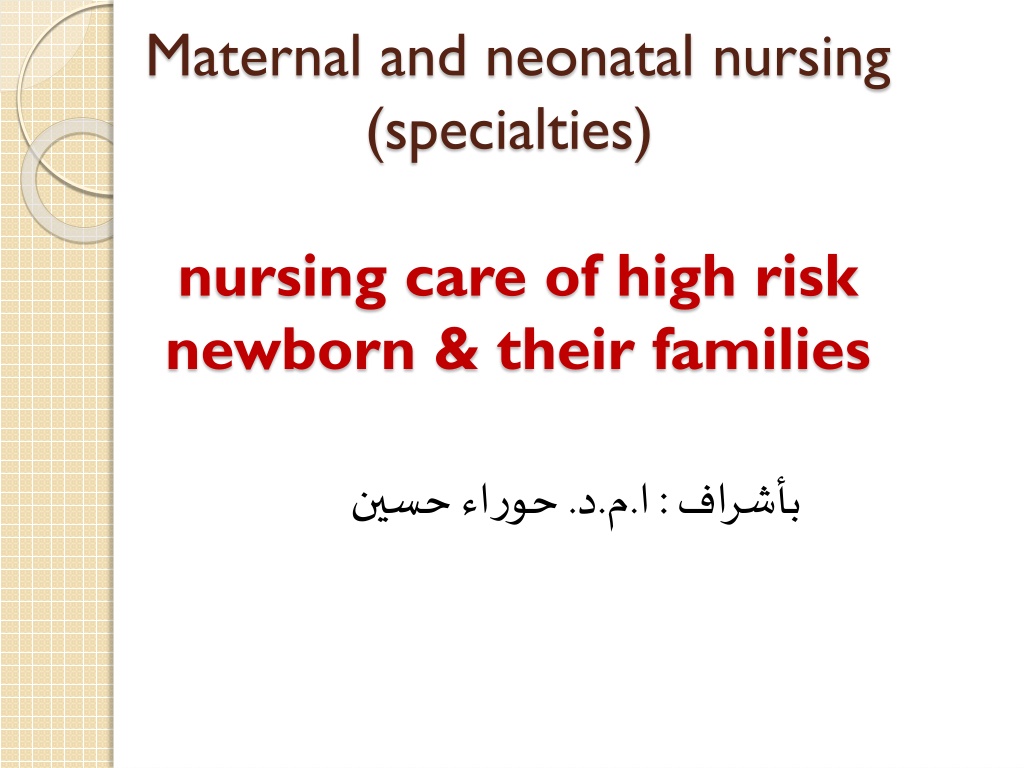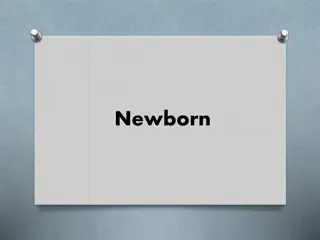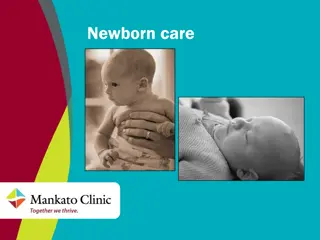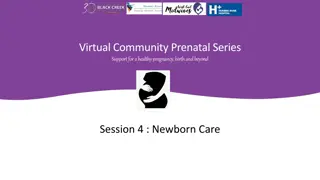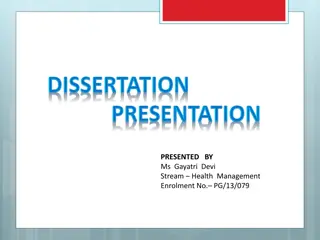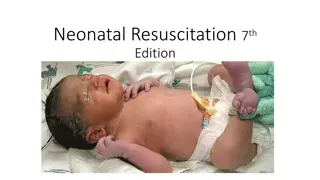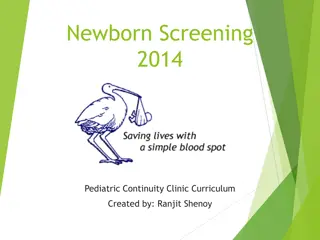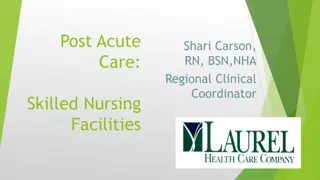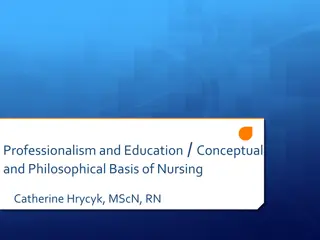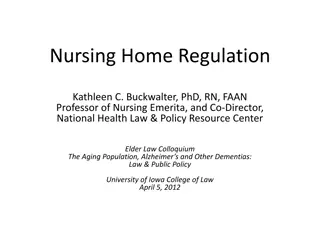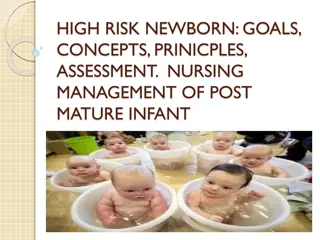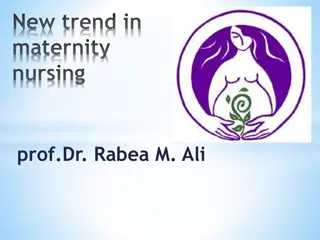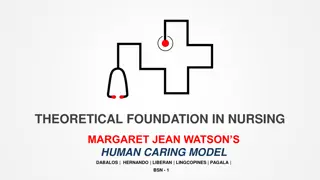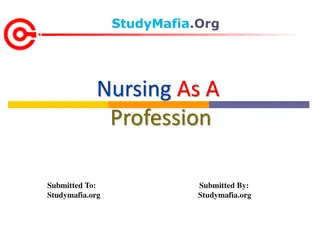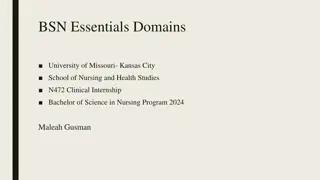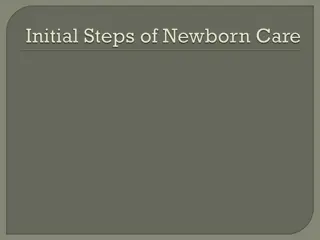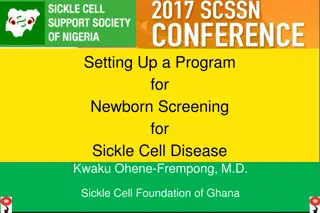High-Risk Newborn Nursing Care and Factors
Maternal and neonatal nursing specialties focus on providing care for high-risk newborns and their families, who face conditions endangering the neonate's survival. Factors contributing to high-risk newborns include high-risk pregnancies, maternal medical illnesses like diabetes, labor complications, and neonatal issues such as asphyxia. Identifying high-risk newborns involves prematurity, low birth weight, hypothermia, hyperthermia, hypoglycemia, respiratory disorders, hyperbilirubinemia, RH incompatibility, congenital anomalies, and intrauterine growth retardation. Nursing care for preterm and low birth weight infants includes intensive care, nutrition and hydration maintenance, breathing support, temperature regulation, early stimulation, complication management, family support, discharge planning, follow-up care, and home care.
Download Presentation

Please find below an Image/Link to download the presentation.
The content on the website is provided AS IS for your information and personal use only. It may not be sold, licensed, or shared on other websites without obtaining consent from the author. Download presentation by click this link. If you encounter any issues during the download, it is possible that the publisher has removed the file from their server.
E N D
Presentation Transcript
Maternal and neonatal nursing (specialties) nursing care of high risk newborn & their families : . . .
High risk newborns any baby exposed to any condition that make the survival rate of the neonate at danger
Factors that contribute to have a high risk newborn: 1)High risk pregnancies: e.g. : toxemias 2)Medical illness of the mother : e.g. :Diabetes mellitus 3)Complication of labor :e.g premature rupture of membrane (prom) ,obstructed labor, or C.S). ) ceasarian section 4) Neonatal factors: e.g Neonatal asphyxia .
Identification of some high-risk newborn. 1)premature birth . 2) low birth weight 3)Hypothermia and hyperthermia 4)Hypoglycemia 5)respiratory disorder. 6) Hyperbilirubinemia 7) RH Incompatibility 8) Congenital anomaly . 9) intrauterine growth retardation. (IUGR)
1-Premature birth Also known as preterm birth is the birth of a baby at a fewer than 37 weeks gestation age Symptoms: of preterm birth include four or more uterine contractions in one hour. Cerebral palsy ,delays in development ,hearing and sight problems .these risks are greater the earlier a baby is born.
2-Low birth weight : IS any live born baby weighting 2500 gram or less at birth .very low birth weight(VLBW ):less than 1500 gm., extremely low birth weight (ELBW): less than 1000 gm. Causes: by preterm birth ( that s alow gestational age at birth ) or the infant begin small for gestation age ( that s a slow prenatal growth rate ) or combination of both. the risk factors in the mother include: young age, multiple pregnancy ,previous LBW,poor nutrition .environment risk factor such as smoking .
Nursing care for preterm, low birth weight and their families 1-care at neonatal intensive care unit 2-maintenance of nutrition and hydration 3- maintenance of breathing 4-maintenance of stable body temperature 5-gently early stimulation 6-prevention, early detection and promote management of complication 7-family support discharge, follow-up and hom care
3-Hypothermia and hyperthermia Hypothermia : its acondition characterized temperature less than 36C . hypothermia classified according to causes and severity. according to causes(primary hypothermia :immediately associated with delivery and secondary hypothermia this occurs due to factors).according to severity (mild Temp less than 36C ,moderate Temp less than 35.5C and severity hypothermia Temp less than 35C).
Hyperthermia :its acondition characterized by elevation body temp more than 37C. Nursing care for newborn with Hypo-hyperthermia and their families. 1-newborn should be warmed quickly by wrapping In a warm towel. 2-if the infant in incubator ,increase the temperature. 3- avoid exposure to direct source of air drafts. 4-check body temperature and give antibiotics if infection is present. 5-if in hyperthermia ,undress the newborn 6-reduction of incubator temp. 7-increase fluid intake to prevent dehydration 8- family health education . .
4-Hypoglycemia: is the most common metabolic disorder. Small gestational age (SGA) newborn. the plasma glucose concentration at or below 40mgl clinical manifestation include (tremor ,poorly feeding ,cyanotic spells .poor reflexes) nursing care for newborn and their familiy with hypoglycemia . 1)Ensure airway, breathing, circulation( ABC). 2)newborn should be start breast feeding or artificial milk. 3)moniter glucose level pre and post feeding 4) if the newborn high risk and unable to feeding give IV fluid . 5)mother education and give her information about hypoglycemia
5-Respiratory disorder : is a medical term that encompasses pathological condition affecting the organs and tissues that include respiratory distress syndrome (hyaline membrane) disease: Transient tachypnea newborn ,meconiuma aspiration syndrom and apnea . Nursing care for newborn and their Families. 1)maintain adequate respiratory status 2)maintain adequate of hydration and nutritional status . 3) avoidance of breast feeding 4) basic support include thermal regulation and medication (antibiotics). family 5) supportandeducate
6-Hyperbilirubinemia:(pathologic jaundice): condition characterized by bilirubin level that exceed 6mg/dl within the first 24 hr after delivery and remains elevated beyond 7days in a full-term neonate and 10days in a premature neonate, bilirubin level that rise by more than 5mg/dl/ day, a level that greater than12mg/dl in premature. .
Nursing care for newborn with hyperbilirubinemia . 1) put the newborn in incubator with phototherapy and cover eyes to prevent retinal damage . 2)newborn should be start breast feeding 3)monitor test (TSB). 4) administration Iv fluid and medication as order. 5)educated and give information about it
7-Rh incompatibility: it occurs when an Rh negative mother carries an Rh positive fetus .leakage of fetal Rh antigens commonly occur during delivery ,at the time of placenta separation ,maternal antibodies are produced in response ,in asubsequent pregnancy with an Rh-positive fetus ,maternal antibody enter the fetal circulation transplacentally, causes erthroblastosis . Nursing care for newborn and their family 1) make the blood groub and Rh test as order . 2)give anti D to the mother as order. 3) give information about disorder to the parents
8-Congenital anomaly : Congenital anomaly (CA) : is an anomaly that affects a body part or physiologic function and is present at birth .it causes by the abnormal ontogenetic development of the fetus ,the process is affected by genetic, environment or by both factors .the most commom congenital anomaly are ( spinal bifida ,,down syndrome ,hydrocephalus , cleft lip and palate ,congental heart disease )
9-IUGR: IUGR: refers to poor growth of afetus while in the mothers womb during pregnancy . Many causes that include Maternal (pre-pregnancy weight and nutrition status, anemia,alcohol,smoking). Uteroplacental (preeclampsia ,multiple gestation ,uterinemalformation). Fetal (chromosomal abnormalities) . there are 2 major categories of IUGR symmetrical and asymmetrical growth restriction.the goals of management is to deliver the most mature fetus in the best physiological condition possible .
References 1-Bobak,I.Maternity and Gynecologic Care : The nurse and the Family ,4thed. St. 2-Louis:Mosby-Year Book,Inc.1988. 3-Wilkerson,N.Acomprehensive Look at Hyperbilirubinemia ,MCN13(5):360- 4-64,September /October 1988. 5-P07-Disorder related to short gestation and low birth weight in ICD-10 6- Labor and delivery Low Birth Weight Umm.edu .2008-10-22. http//www.Vrozene-Vady.cz/ - 7
